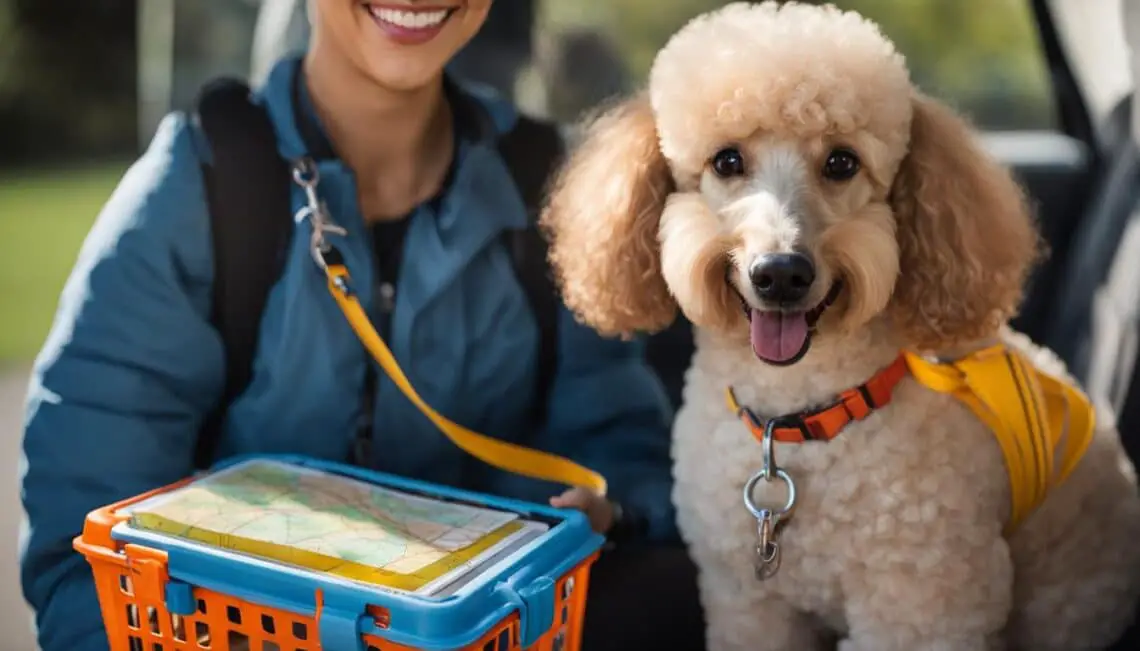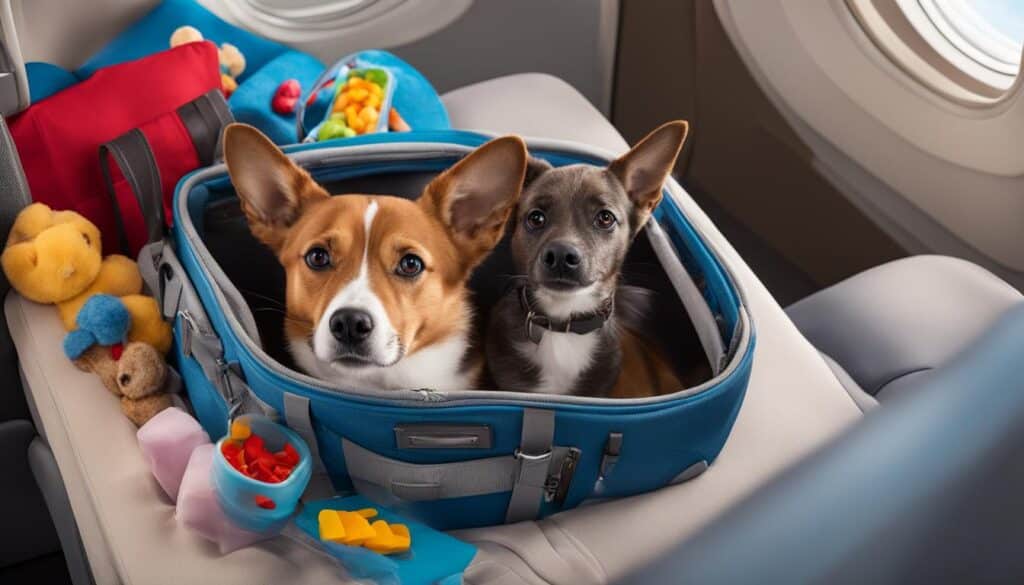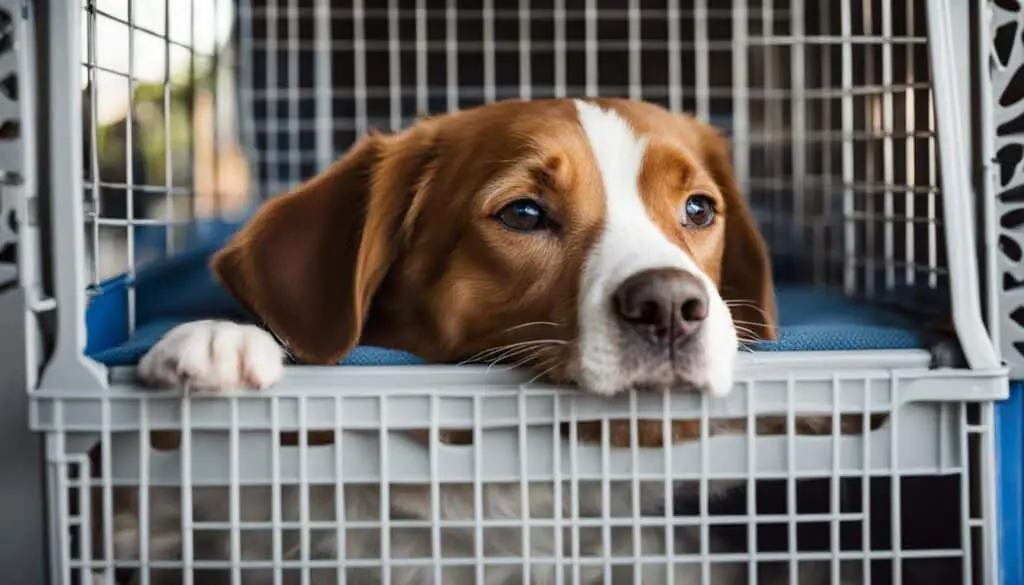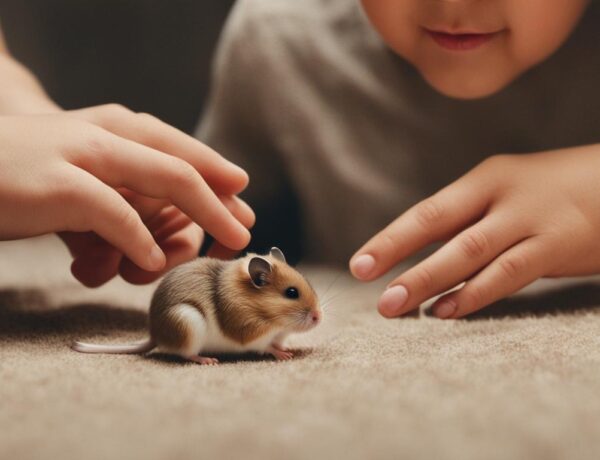Whether you travel with your dog daily or you would like to enjoy your dog’s company when you go on holiday or visit friends and family, there are some preparations needed for their safety and emotional well-being. It is also helpful to have a plan for those situations in which your dog cannot join you, such as a pet sitter or boarding kennel. In most cases, some type of confinement is needed for at least a portion of the trip. All commercial airline carriers require pet dogs to remain in crates during the flight, while waiting to board, and while moving about the airport. Service dogs may be exempt. When traveling in a car, your dog should be secured by a crate or a seat belt and harness. By training your dog to remain relaxed and comfortable when confined, you ensure your dog can relax, regardless of the duration of the trip.
Key Takeaways:
- When traveling with your pet, it is important to prepare them for safe and comfortable travel.
- Commercial airline carriers require pet dogs to remain in crates, while cars require confinement using a crate or a seat belt and harness.
- Confinement training is essential to help your pet relax and remain calm during the journey.
- Gradual acclimation to confinement and positive reinforcement can make travel more comfortable for your pet.
- Consulting with a veterinarian can provide additional guidance and solutions for any travel-related concerns or anxieties your pet may have.
Preparing your pet for travel is a crucial aspect of ensuring their safety and comfort during the journey. By training your pet to be relaxed and calm when confined, whether in a crate or secured by a seat belt and harness, you can create a stress-free travel experience for both you and your furry friend. In the following sections, we will explore essential tips and techniques to help you train your pet for car and airplane travel.
Confinement Training for Safe Travel
Confinement training is an essential step in ensuring the safety and well-being of your pet during travel. Whether you are flying with your dog or taking a road trip, proper confinement is crucial to prevent accidents and distractions.
Commercial airline carriers require pet dogs to remain in crates during the flight, while waiting to board, and while moving about the airport. Service dogs may be exempt from this requirement.
When traveling by car, it is important to secure your dog with a crate or a seat belt and harness. This not only keeps them safe but also prevents them from interfering with the driver’s vision or movement.
Crates are especially beneficial during car accidents as they provide protection and limit the risk of injury for your pet. On the other hand, seat belt harnesses like the SleepyPod ClickIt Sport Harness offer a portable and secure option, ensuring your pet’s safety during travel.
To get your dog accustomed to being confined, start by sitting with them in the car in your driveway. Gradually introduce them to the crate or seat belt by allowing them to explore and rewarding them with treats. Using a calming pheromone spray can also help them relax and associate positivity with confinement.
If your dog already displays signs of anxiety or restlessness in the car, it’s important to consult your veterinarian for potential solutions. They can provide guidance on behavior modification techniques or recommend anxiety-reducing products that may help your pet feel more comfortable during travel.
Remember, confinement training is a vital part of ensuring a safe and stress-free journey for your pet. By following these guidelines and preparing them for confinement, you can enjoy worry-free travels with your furry companion.
Benefits of Confinement Training
| Benefits | Description |
|---|---|
| Ensures Safety | Prevents accidents and distractions, keeping your pet safe during travel. |
| Minimizes Risk of Injury | Crates provide protection during car accidents, reducing the chances of injury for your pet. |
| Promotes Relaxation | Confinement training helps your pet feel more relaxed and comfortable during the journey. |
| Prevents Interference | Securing your pet with a crate or seat belt harness prevents them from interfering with the driver’s vision or movement. |
Training for Car Travel
To ensure your dog’s comfort and safety during car travel, it is important to acclimate them to the car and the various means of confinement.
There are different types of travel crates available, such as heavy-duty crates like the MIM Variocage and the Ruff Land kennel, or lighter options that can be secured with a seatbelt or strap.
Gradually introduce your dog to being confined in the car by starting with short trips to familiar places and gradually increasing the duration of the drives.
Use treats and positive reinforcement to create positive associations with the car.
If your dog shows signs of distress or anxiety during car travel, such as salivating, restlessness, pacing, whining, howling, or vomiting, consult your veterinarian for possible solutions.
Desensitization and counterconditioning techniques can be used to reduce anxiety and create a positive emotional response to car travel.
| Types of Travel Crates | Description |
|---|---|
| Heavy-duty crates | Provides maximum protection during accidents and secure confinement for larger dogs |
| Lighter options | Can be secured with a seatbelt or strap for smaller dogs |
Training for Airplane Travel
Airplane travel can be a stressful experience for pets, especially due to the unfamiliar environment and extended periods of confinement. To ensure your dog’s well-being during air travel, it is crucial to prepare them for these challenges.
One effective way to acclimate your dog to airplane travel is by gradually introducing them to the travel carrier. Start by placing the carrier in a common area of your home and adding their favorite toys, treats, and meals inside. This will help create a positive association with the carrier and make it a more inviting space for your dog.
Allow your dog to explore the carrier on their own terms and become comfortable with it. Encourage them to enter the carrier voluntarily and reward them with treats or praise. Practice closing the door for short sessions and gradually increase the duration over time. This will help your dog get used to being confined in the carrier and prepare them for the confinement they will experience during the flight.
If your dog is traveling in cargo, it is essential to simulate the handling they will receive during the trip. Practice lifting and moving the carrier to familiarize them with the sensations and ensure they feel secure during the journey.
Another important aspect of airplane travel is bathroom breaks. Many airlines provide designated indoor areas with artificial turf or potty pads for dogs to relieve themselves. To prepare your dog for this, introduce them to artificial turf or potty pads during their regular bathroom routine. This will help them become familiar with using these surfaces and eliminate any potential stress or confusion during air travel.
It is also crucial to familiarize yourself with the specific requirements of the airline you will be traveling with. Each airline may have different rules and regulations when it comes to traveling with pets. Ensure you have all the necessary documents, such as health certificates or vaccination records, to comply with the airline’s guidelines.
Tips for Pet Travel Behavior
When it comes to traveling with your pet, ensuring their comfort and well-being is essential. Training your pet for travel behavior can make the journey less stressful for both of you. Here are some helpful tips to promote relaxation in the crate and potty on command:
- Make crate time relaxing: Before flying, it’s important to acclimate your pet to their travel crate or carrier. Start by introducing them to the crate in a positive and calm environment. Use treats, toys, and a familiar blanket to create a comfortable space. Encourage your pet to enter and exit the crate willingly.
- Positive reinforcement: Use positive reinforcement techniques to reward your pet for calm and settled behavior inside the crate. Give them verbal praise, gentle petting, or their favorite treats when they exhibit relaxed behavior. This helps them associate the crate with positive experiences.
- Potty on command: Training your pet to potty on command is beneficial during travel, especially in environments like airports. Start the training process early by using a specific verbal cue or hand signal when you take your pet to their designated bathroom area. Reward them with praise or treats when they eliminate on command.
- Early crate and potty training: Start crate training and potty training as early as possible to give your pet ample time to learn and adapt. Consistency and repetition are key. Gradually increase the duration of crate time and practice potty training in various locations to ensure your pet is comfortable and familiar with different environments.
- Expose your pet to similar situations: If possible, expose your pet to short commuter flights or visit crowded public places. Exposing them to similar situations as air travel can help them become more comfortable with the sights, sounds, and confined spaces they may experience during a flight.
By following these tips and investing time in training, you can help your pet develop the necessary behaviors for safe and stress-free travel. Remember to be patient, consistent, and always reward positive behavior. Your pet’s comfort and well-being should be your top priority.
For more information and expert advice on pet travel behavior, consult a professional pet trainer or veterinarian.
Conclusion
Training your pet for safe and comfortable travel is crucial to ensure their well-being during the journey. By following proper preparation, safety measures, and behavior training, you can create a stress-free and enjoyable experience for both you and your furry friend.
Confinement training, such as getting your pet accustomed to their travel crate or seatbelt harness, is essential for their safety and security. Acclimating them to car travel by gradually introducing them to short trips and positive associations with the car helps reduce anxiety and discomfort.
Similarly, preparing your pet for airplane travel involves gradually getting them used to the travel carrier, artificial turf or potty pads, and replicating the handling they will experience in cargo. Familiarizing yourself with airline requirements and carrying necessary documents are also vital.
Remember to start early, be patient, and use positive reinforcement during the training process. If your pet exhibits signs of distress or anxiety, consult with your veterinarian for guidance and possible solutions. By implementing these tips and guidelines, you can ensure a safe, comfortable, and enjoyable travel experience for your beloved pet.
FAQ
What is confinement training?
Confinement training is necessary before travel to ensure the safety and well-being of your pet. It involves acclimating them to being confined in a crate or secured with a seat belt and harness.
Why do I need to secure my dog in a crate or with a seat belt and harness during car travel?
Securing your dog prevents them from interfering with the driver’s vision or movement. Crates also provide protection during accidents, while seat belt harnesses offer a portable and secure option.
How can I get my dog used to being confined in the car?
Start by sitting with them in the car in your driveway and gradually acclimate them to the crate or seat belt. Use treats and calming pheromone spray to help them relax. Consult your veterinarian if your dog is already anxious in the car.
What types of travel crates are available for car travel?
There are heavy-duty crates like the MIM Variocage and the Ruff Land kennel, or lighter options that can be secured with a seatbelt or strap.
What should I do if my dog shows signs of distress during car travel?
Consult your veterinarian for possible solutions. Desensitization and counterconditioning techniques can be used to reduce anxiety and create a positive emotional response to car travel.
How can I prepare my dog for airplane travel?
Gradually introduce them to the travel carrier by placing it in a common area of your home and adding their favorite toys, treats, and meals inside. Practice closing the door for short sessions and gradually increase the duration.
What should I do if my dog is traveling in cargo?
Practice lifting and moving the carrier to simulate the handling it will receive during the trip. Familiarize yourself with the airline’s specific requirements and carry all necessary documents for air travel with your pet.
How can I ensure my dog is comfortable with their travel crate or carrier?
Use positive reinforcement and rewards for calm and settled behavior. Train your dog to potty on command in a variety of environments. Start early with crate training and potty training to give your pet ample time to learn and adapt.
What should I do if my dog shows signs of distress or anxiety during air travel?
Consult with your veterinarian for possible solutions. Desensitization techniques and exposure to similar situations can help reduce anxiety. Patience, consistency, and repetition are key to teaching your pet the desired behaviors for air travel.
Why is training my pet for safe and comfortable travel important?
Training your pet ensures their well-being during the journey. Confinement training, acclimating to car travel, and preparing for airplane travel are all necessary steps to guarantee a stress-free experience for both you and your furry friend.







No Comments